Coogee Media
HISTORY | STORIES | BEYOND BLOG & CREATE PEOPLE |
Glenwood Avenue, Coogee
|
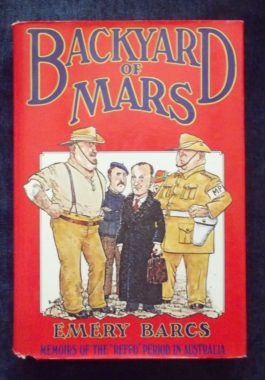 Book Cover: Backyard of Mars | 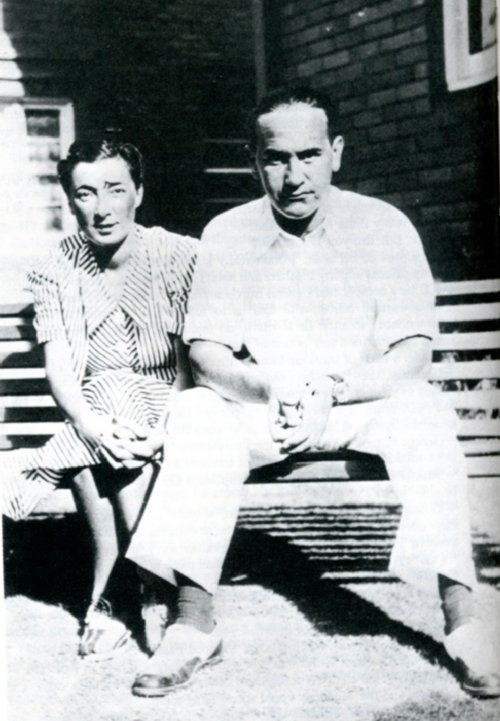 Vica & Emery Barcs: 5 Glenwood Av. |
One early resident of the street was Dr Emery Barcs (1905 - 1990) (and his wife Vica), the notable Hungarian-Australian journalist and author. The couple escaped the rise of fascism in Europe and settled in Coogee in late 1939, just at the beginning of the Second World War. After and stint in a "3rd rate" Coogee boarding house, they rented a flat at No. 5 Glenwood Avenue and set about recreating a little bit of what they remembered of a lost middle European culture. Emery Barcs writes about his life in Glenwood Avenue in some detail in his 1980 biography Backyard of Mars: memoirs of the "Reffo" period in Australia
The Barcs were committed to a new life in Australia and Dr Barcs worked as a journalist and talks writer for a number of organisations including the Australian Broadcasting Commission (ABC) while he tried to join the Australian Army as part of the effort to fight fascism.
To his dismay, because he knew some Australians disliked the idea of immigrants living together in one area forming "ghettos", the Barcs were soon followed to Glenwood Avenue by other Hungarians, creating a little Hungarian enclave by the seaside. Glenwood Avenue soon developed a cosmopolitan air.
Dr Barcs describes the events in December 1941 (after the Japanese had attacked Pearl Harbor) when late one evening there was a knock at his door at No. 5 Glenwood Avenue by a detective policeman who had come to take him (and another Hungarian neighbour living at another flat in No. 5) into what was known as internment of "aliens" as a war precaution. As Hungarian, they were now technically citizens of an enemy power. After some weeks, when authorities were convinced of his bona fides he was released and he describes the relief of driving down Dolphin Street Coogee, to his little piece of mittel Europa in Glenwood Avenue. The couple were able to spend the rest of the war years here in Coogee until he had completed his service with the Australian Army.
World War Two Air-raid Shelter
In 1942, the owners of eight blocks of flats in Glenwood Avenue got together to form a "Glenwood Avenue Protection Association". Each of the flat owners were asked
to donate £12 towards the construction of an "underground bomb proof shelter" in the backyard of one of the residents, Mr A. D. Foley. The 145 feet long,
6 feet high trench with a roof of thick oregon timber topped with sand could hold 130 people. Press photographs show three men standing in the impresssive
structure.
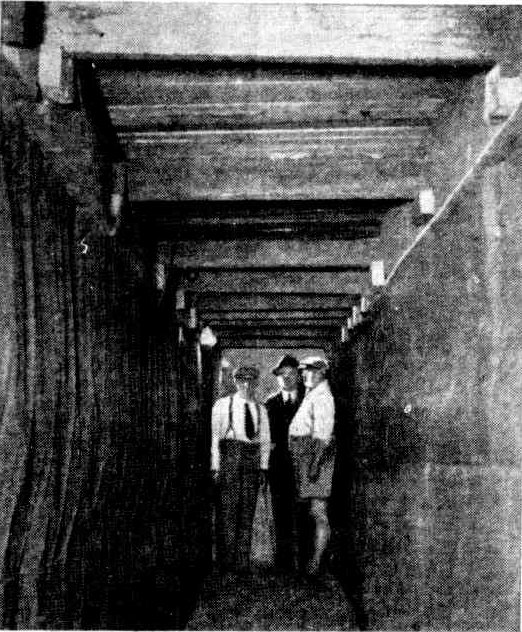
The underground shelter at Glenwood Avenue
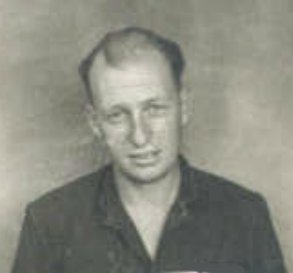
William John Stones, c1940 RAAF Enlistment Photo |
Stones Milk Bar & Nightclub Another resident of the Avenue, also at No. 5, was William John Stones (1916 - 1982) - the son of William and Bridget Stones, the owners and operators of Coogee's iconic Stones milk bar and night-club that operated in Dolphin Street, near the Beach. He enlisted in the Royal Australian Air Force, and when he was discharged from war service in October 1945, he changed his address from the residence at Stones to Glenwood Avenue and settled down to a post-war life in the street. You can READ MORE about the Stones family.
Baby Boomers |
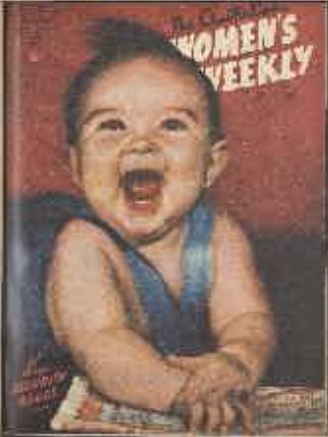
Infant Michael Liddy in 1946
Making a New Home
Emery Barcs' observation about the street becoming a centre of middle European domicile in Coogee, was correct. In the post-war era, many residents made
press announcements (as they were officially required to do) of their intention to become naturalised citizens. Lily Buchwald (also know as Buckwall) who
lived at flat 4, No 5 Glenwood Avenue (the same building Barcs lived in) made such an application in October 1946, for instance. Erwin Furst of no 2 Glenwood Avenue
made an announcement in April, 1945. Others followed. Clearly, people were making long term plans to settle.
Local Jewish Community
Glenwood Avenue played an important part of the history of the local Jewish community.
In 1954 Olga Hochstadt of Unit 3, No. 10 Glenwood Avenue, who came from the town of Borsa in what was then Czechoslovakia, announced that after living in Australia for five years, she intended to apply for citizenship naturalisation. The Hochstadt family members were to become prominent figures in the street, and it their garage (which handily opens almost directly onto the street) became the temporary site of many functions of the Coogee Jewish community in the 1950s while the Coogee Synagogue was being constructed. In 1953, Abraham Hochstadt was inviting members of the Coogee, Randwick, Clovelly Hebrew Congregation to its first General Meeting.
No 10 Glenwood Avenue is a two storey building, like the rest of the buildings in the street, but with its central checkerboard arrangement of glass bricks above the main entrances, and rounded balcony metal balustrades, is in the style of the inter-war Ocean Liner architectural style.
The congregation was finally able to move to newly constructed Synagogue in Brook Street in January 1961. The Hockstadt maintained their presence in the street for some time after that. By 1975, Jacques and Olga Hockstadt were living in unit 3 when they passed on condolences for the death of their uncle Leo Marcus Rosewald from unit 4.
Divorce
Up until the Whitlam Government introduced no-fault divorce reform legislation in the 1970's, court cases involving divorce were standard fare for
newspapers seeking out gossip involving anyone who came before the divorce courts with but the slightest of a public profile. It seems cruel now,
but the accounts do provide a fascinating insight into the lives of many people who would otherwise go unnoticed. So it is the case in 1949 of Noni Elizabeth
Leveson (1917 - 1995), a daughter of the remarkable politician and journalist Voltaire Molesworth (1890 - 1934). She lived at Flat 2, No. 1 Glenwood Avenue with her errant
accountant husband Mr John Leveson (1914 -1993). He had an affair with a Nancy Falconett, who worked with him in the offices of the newspaper The Newsletter
operated by Voltaire Molesworth Junior (Noni's brother). (See Note 1)
The newspapers of the day lapped up all the juicy details including the claims by each of Mr Leveson's amore that they would kill themselves if they could not have their man to soley to themselves. No newspaper sought out any salacious detail more eagerly than the Truth who revealed that Noni came across her husband's affair by accident when she saw her husband and Miss Falconett "talking together" through a window as she passed by the Newsletter offices on a tram! Mrs Leveson was granted a divorce and presumably, one of them had to leave the Glenwood Avenue. John Leveson and Nancy Falconett later married.
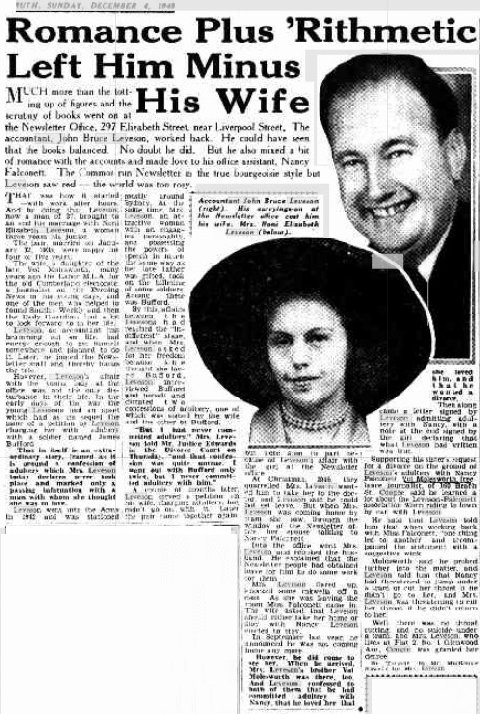
Truth newspaper article with divorce case of Mr and Mrs Leveson
Crime
I tried to seek out any stories or data about crime in the street; however, it appears the residents must have all had a fairly peaceable life
over the decades. One account I came across involved a greyhound racing bookmaker William Hilder in Aug 1945. He reported to police that a robber had entered
his Glenwood Avenue flat through a window and stole the then considerable amount of £280 in cash hidden in a wardrobe, while he and his wife slept. To make
matters worse, the thief had also taken £2 10s from his wife's purse.
References
Copyright © Coogee Media All rights reserved.
| CONTACT US | ABOUT US |
